Breaking Beta | Is This the Best Hangboard Protocol?

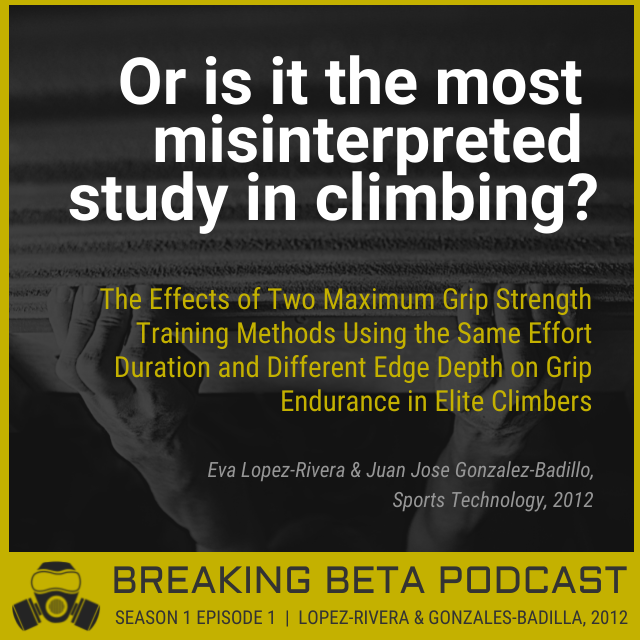
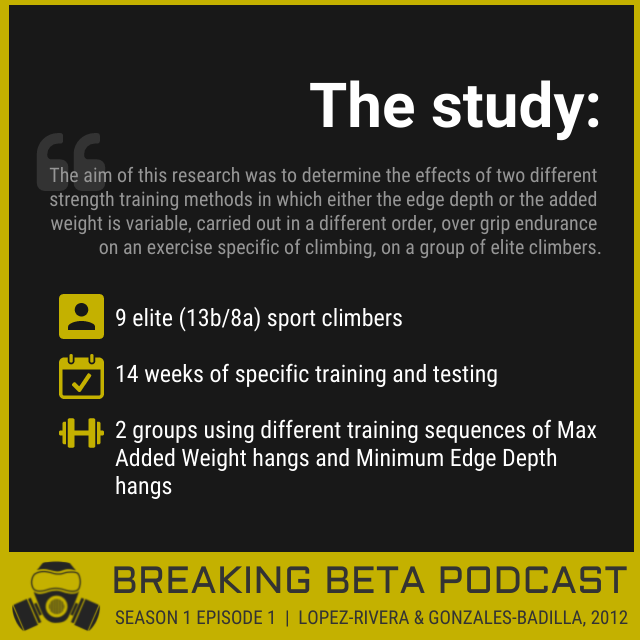
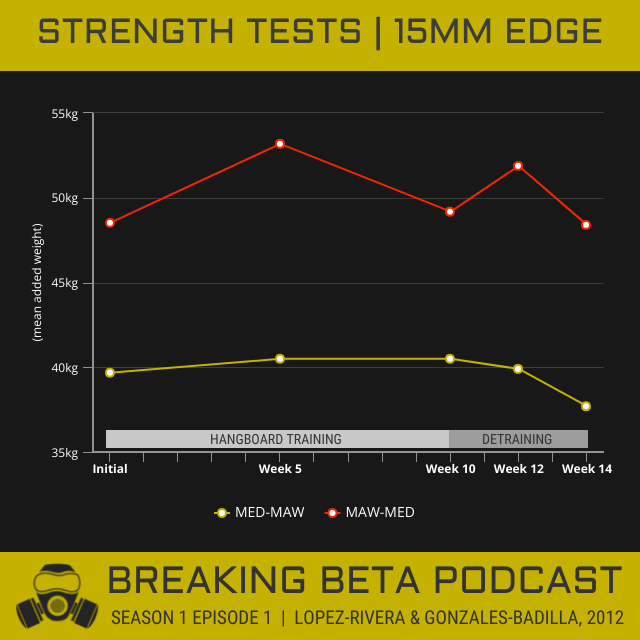

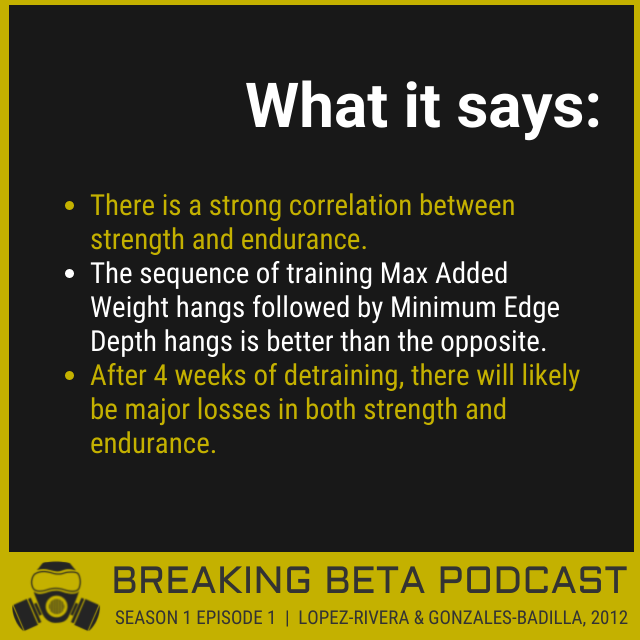
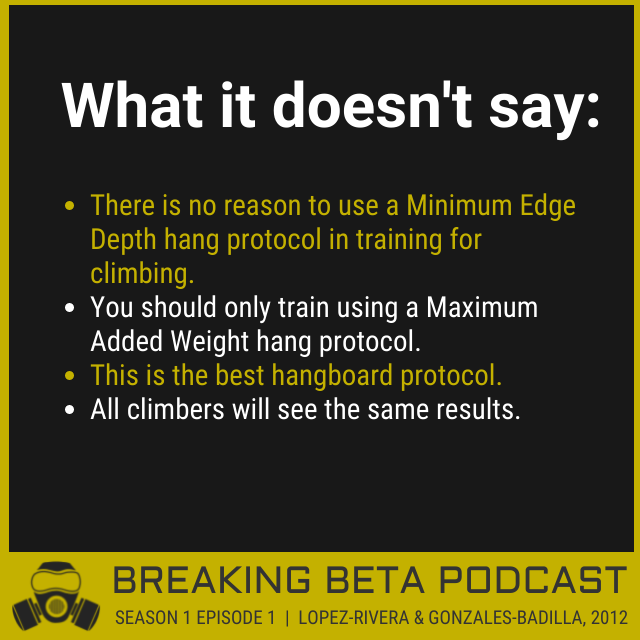
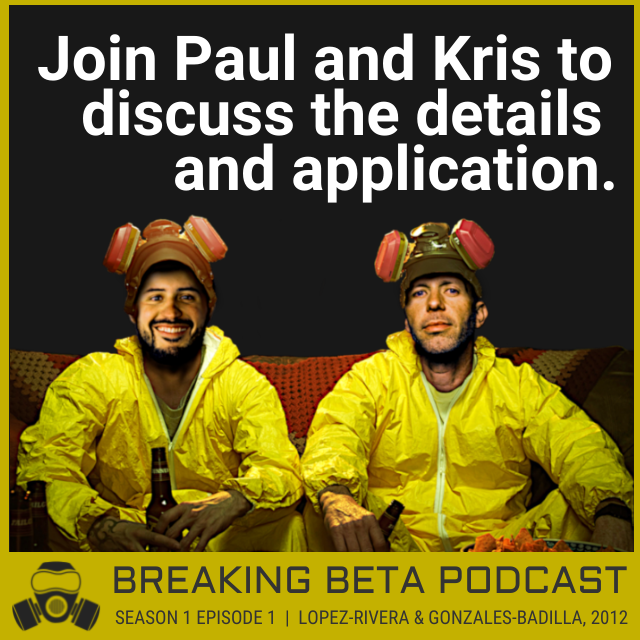
In this episode, Kris and Paul discuss what might be the most popular study in all of climbing:
The Effects of Two Maximum Grip Strength Training Methods Using the Same Effort Duration and Different Edge Depth on Grip Endurance in Elite Climbers
authored by Eva Lopez Rivera and Juan Jose Gonzales-Badillo; published in Sports Technology in 2012.
They’ll try to determine if this study provides evidence for one hangboard protocol to rule them all, or if folks have just been misinterpreting the data. Tune in to see who wins in the finger strength battle between Minimum Edge Depth and Maximum Added Weight!
New episodes of Breaking Beta drop on Wednesdays. Make sure you’re subscribed, leave us a review, and share!
And please tell all your friends who are constantly telling you that their hang protocol is the number one best protocol, that you have the perfect podcast for them.
Got a question? Comments? Want to suggest a paper to be discussed? Get in touch and let us know!
Breaking Beta is brought to you by Power Company Climbing and Crux Conditioning, and is a proud member of the Plug Tone Audio Collective. Find full episode transcripts, citations, and more at our website.
FULL EPISODE TRANSCRIPT:
Breaking Bad Audio Clip 00:06
Where do you want me with this?
Start 40 feet out. It's more than the length of the room.
Who's doing the honors?
Me.
Flip that switch turns it on, twist this here, that's your power control.
Alright.
Everybody ready?
Yeah.
Okay.
Fire in the hole!
Kris Hampton 00:21
That seemed like an appropriate way to start Season One, Episode One of the Breaking Beta Podcast.
Paul Corsaro 00:29
I like it. I'm quite the fan.
Kris Hampton 00:31
Yeah, no doubt and that's a great scene too. I really wanted to just put "Magnets, bitch!" in here, but but decided not to. Though I guess I just put it in here.
Paul Corsaro 00:43
It will find its way in at some point.
Kris Hampton 00:45
Yeah, I think this is probably the the most famous, most cited paper in all of climbing. Would you agree with that?
Paul Corsaro 00:54
I would say so. It's definitely at least one of them. I remember back when it first got published, pretty quickly after it was published, it was being shared around everywhere. Everyone was talking about it. I think you know, a lot of climbers, just psyched to see some formal research paper get published on training for climbing because I think it was the first of its kind really, that I can remember. I'm sure there's some out there.
Kris Hampton 01:15
As far as I know, it was and we're talking about Eva Lopez's first research study that came out with the Transgression and Progression boards or are at least around the same time. And as far as I know, was the first time we really saw a systematic hangboard as well. Like hangboards before that seemed to just have a random assortment of holds and Eva really made it like a stepwise progression sort of a board. And this study came out with it, so I think that excited people as well.
Paul Corsaro 01:50
Mmmhmm. It was definitely a cool kind of look forward into what climbing training has become over the last nine years. Is my math right on that? Something like that?
Kris Hampton 01:59
Yeah, I think that's right. So the the official title of this paper is "The Effects of Two Maximum Grip Strength Training Methods Using The Same Effort Duration and Different Edge Depth On Grip Endurance In Elite Climbers." Authors are Eva Lopez-Rivera and Juan Jose Gonzalez-Badillo. And the purpose of the paper, I'll just I'll read what they've got here in the paper. I think this sums it up really well. "The aim of this research was to determine the effects of two different strength training methods in which either the edge depth or the added weight is variable, carried out in a different order over grip endurance on an exercise specific of climbing on a group of elite climbers." Something I thought was really interesting here, before we jump into talking about the paper is that when they state the aim of it, they're asking about grip endurance, so it wasn't a asking about strength paper at all. It was more, "How long can you hold on?".
Paul Corsaro 03:10
Yeah, so it'll be interesting to see what they kind of dug up throughout the course of that study.
Kris Hampton 03:14
Yeah, no doubt. All right, let's jump into this thing.
Breaking Bad Audio Clip 03:18
You clearly don't know who you're talking to. So to be clear,
Paul Corsaro 03:23
I'm Paul Corsaro.
Kris Hampton 03:25
I'm Kris Hampton.
Breaking Bad Audio Clip 03:26
Look, you two guys are just guys,
Paul Corsaro 03:30
And you're listening to Breaking Beta,
Kris Hampton 03:32
Where we explore and explain the science of climbing.
Breaking Bad Audio Clip 03:36
With our skills, you'll earn more than you ever would on your own.
Breaking Bad Audio Clip 03:41
We've got work to do. Are you ready?
Paul Corsaro 03:45
I'm ready, are you?
Kris Hampton 03:47
Dude, I am chomping at the bit here. I'm so excited. I've had so much fun reading through these papers for days and days, spending hours on it instead of like, a cursory look and just making a quick knee jerk decision from that.
Paul Corsaro 04:05
100%. All the highlights, all the notes, all the things.
Kris Hampton 04:09
Yeah, first, let's uh, let's talk about the methods used in this study.
Breaking Bad Audio Clip 04:14
In a scenario like this, I don't suppose it is bad form to just flip a coin.
Kris Hampton 04:22
So they had... the people who finished the study anyway, there were nine sport climbers.
Paul Corsaro 04:30
Correct.
Kris Hampton 04:31
Eight men, one woman, which is a little bit unfortunate, that they only had one woman. And their level was that 13b/8a or higher, so pretty elite sport climbers here and they haven't done any deadhang training for two months prior.
Paul Corsaro 04:51
I thought that was a really smart, little inclusion criteria for the people in the study because you know, especially people at that grade or who've been climbing and have that level of experience, a lot of them are training, going through a training cycle. So I could see it getting really confusing pretty quickly if you had people coming in, like all different levels of trained status from where they're at. So I thought that was a really cool way of kind of standardizing the people coming in and making sure they weren't gonna have any confusing hidden variables in there.
Kris Hampton 05:22
Yeah, I agree and it, it sort of seems like if you took just beginner climbers, a, you're going to see some wild gains, regardless. Almost anything helps, you know, so having more experienced climbers makes it so you can at least guess that you're dialing down what it is that's, that's showing gains or not, you know, so I thought that was smart.
Paul Corsaro 05:49
And not just climbing, you know, 13b around, but they had... everyone had been climbing for at least five years too, so that was another kind of control that was... I thought was great, kinda along those same lines.
Kris Hampton 05:58
Mm hmm. Super smart. I wonder if today it would be harder to find a group of 13b or stronger climbers who hadn't done any deadhang training for two months prior?
Paul Corsaro 06:12
That's a really good question. I'm sure there'd be some, but it probably be pretty tough, especially with how, you know, well-incorporated hangboarding is and the idea of training for climbing, it's almost a part with everything.
Kris Hampton 06:24
Yeah, totally. The researchers created a device to measure and it was, it's essentially, at the time, it was kind of a new thing, but it's essentially an adjustable wooden edge. And we see quite a few of these today, but but they did make it so all the edges, you're hanging on the same edge, it's just different depths, which I think is pretty smart as well.
Paul Corsaro 06:49
Pretty simple, yet super effective design. Just two wood blocks and a little screw you could turn to just dial in the edge depth. So simple, but effective. I like that.
Kris Hampton 07:02
Yep. And they, they did initial tests to see their strength, their endurance and then they split them into two groups. And the two groups, the way they trained was, and maybe we should explain this a little bit, before we jump into any more of the study. Group A went from minimum edge depth training to maximum added weight, and Group B went from maximum added weight to minimum edge depth. And I will probably just call those maximum weight or minimum edge or MAW or MED, as we go through this, so just just so people know what we're talking about here. And minimum edge depth essentially was what's the smallest edge you can hang on for the given amount of time, maximum added weight is the edge size stays static and we're adding weight to to increase the load.
Paul Corsaro 08:01
In the training they used, I thought it was cool, because you know, one of the first instances in climbing training where you see people using a subjective measure to kind of guide how hard you make things. So they always use that kind of three seconds in reserve as their guideline. And if they felt like they were below that three seconds in reserve, they'd increase the intensity either by making the edge smaller if you were the the MED group, or adding some weight if you were the maximum added weight group. So I thought that was cool to see, because I've been using, in my training, a little bit more of that as of late. So it's been around for a while. It's cool to see.
Kris Hampton 08:35
Yeah, exactly. It's the the idea of auto regulation, though, you know, they don't name it that in this paper. Very...I thought that was interesting to look back and see that that's how they did it during the study as well.
Paul Corsaro 08:49
Another thing I thought was cool about the testing was for both maximum added weight, or for the strength test and for the endurance test, they stopped the test when the participant started flexing the elbows or lifting their legs. I thought that was cool.
Kris Hampton 09:04
It was interesting.
Paul Corsaro 09:05
Because I've been you know, we've all been there, hanging on an edge and you're trying hard. And I'll tell you what, my elbows flex and my legs lift sometimes, so.
Kris Hampton 09:12
Oh, yeah, totally. I mean, if we look at all the images of people on Instagram hanging they are like 90 degrees or more pulled up with their elbows, their knees are up by their chest, they're in a little ball. Why do you think they stopped the test like that?
Paul Corsaro 09:30
I think maybe it could have been, you know, we're all hypothesizing on what someone else is thinking here, so I don't really know why, but I would say maybe A, for safety purposes so someone's not about to blow off of an edge trying to get that extra you know second or so, because I know they have to pass a review board and all that so they have to manage risk as much as possible. And maybe it just, <cough> excuse me, maybe it just controls a little better for for numbers. You know, some people might be better at fighting and hanging on that last second, and maybe they're falling out of that half crimp and they start dragging. I think maybe just picking a cut off point before that starts to happen might have just kept things a little cleaner for them.
Kris Hampton 10:10
Yeah, I think so. And I also considered, you know, since this was one of the first studies into hangboarding, maybe they were hypothesizing, as I am about what they're thinking, that if they're pulling up, they're getting muscles involved, rather than just the finger strength and they didn't want to give them that help. So, smart to, you know, have a place where they say, here's, here's where it ends.
Paul Corsaro 10:41
Yeah. One last note on the testing that I thought was also pretty cool, just another really good job of controlling for everything was how they had that participants do that light training session two days before testing. So everyone's kind of coming in at the same kind of rested, recovered level too,
Kris Hampton 10:56
Yep and they understand the testing and what all is going to be happening. So I'm just going to run through kind of the, the schedule that everyone followed, just so we know here. It was essentially a 14 week study. Week 1 and 2 they tested. So Week 1 was kind of a pretest. Week 2, they they test. And they take the I think they took the stronger of those two tests from each person. And then Weeks 1 through 4, they started with just three hangs of 10 seconds, and three minutes in between each hang and they did that twice a week. They move to four in Week 2, five in Week 3 and Week 4. So not a whole lot of hanging, but really intense hanging with long rests in between. And, and remember, there were two groups, one that started with minimum edge depth, one was start with maximum added weight. And then Week 5, they did another test. Week Six through 9, they flipped so the maximum amount of weight group was using minimum edge, the minimum edge group started using maximum added weight. Week 10, they tested again and Week 11 they started resting from the hangboard training. And then they tested again Week 12 and Week 14. So everybody kind of went through the same cycle.
Kris Hampton 11:24
And I thought it was well designed too because you had multiple tests throughout the whole, the whole cycle, so it wasn't just one test in the beginning and one test 14 weeks later. So you get kind of a cool window into maybe some of the processes that are happening throughout the whole program.
Kris Hampton 12:51
Mm hmm. One thing I was a little confused about and not necessarily confused, but I wish this had been controlled more, though I understand why it couldn't be. They note in the study that the participants also trained six days a week, two to four hours a day, consisting of boulder endurance and or power endurance training, with sets of three to 90 moves at 70 to 100% of maximum sport level. So they were all doing training that Eva had devised, but when I read this, I was like, well, that can encompass my entire climbing career. Sets of three to 90 moves at 70 to 100% of maximum sport level, that's everything I've ever rock climbed.
Paul Corsaro 13:39
Right. Yeah, a little bit of variability may be there. I think it did have a good element of that in that still Eva was overseeing all of that. So it wasn't like, "Alright, here's rough guidelines, go do your own thing." So I think that might have helped a little bit with controlling some of the variability that might have been happening outside of the hangboard training.
Kris Hampton 14:01
Yeah, I think so. The the issue I had is that everybody kind of comes in at a different level there. so you know, the endurance training for one person might be affecting someone differently than the other person and making them more fatigued or whatever, you know. I, we don't know how Eva controlled it and that's, that's the only thing in the methods that kind of raised my eyebrows a little bit.
Paul Corsaro 14:30
Would you think that happening though might show that the results we're going to discuss later, have a little bit wider applicability to everybody? Because you know, when people are doing hangboard training, they're not all going to be doing the same climbing training too.
Kris Hampton 14:44
Hmm. Yeah
Paul Corsaro 14:45
So that might reflect just a little bit of effect on people who are doing different things. So
Kris Hampton 14:52
Yeah, more more real world application, instead of instead of the super like stringent, dry results.
Paul Corsaro 15:01
If you're gonna hangboard, you have to do this climbing program.
Kris Hampton 15:03
Haha. Right. Yeah, yeah. Good point. Good point. All right. Before we jump into, is there anything else in the methods you want to talk about? Maybe the, here's something I thought was interesting, and I thought was really smart, actually, is that they didn't test on the same size edges edge that they were hanging on for training. The maximum added weight training was done on a
Paul Corsaro 15:38
It was 18, I think.
Kris Hampton 15:40
Yeah, they trained on 18.
Paul Corsaro 15:42
They tested on 15.
Kris Hampton 15:43
So they tested on 15. I thought that was actually really smart, because we've seen over time that you can train for the test. If you're, if you're really used to hanging on one size edge, then when you go and retest on that edge, you will hang on it better. So you're maybe not getting strength gains or strength results as much as you are just adapt adapting to that edge results.
Paul Corsaro 16:13
Yeah, improving coordination, coordination, if you will, as opposed to just yeah, getting stronger. So yeah, I thought that was cool, too. That was a good, good point to make, not just teaching the test, if you will.
Kris Hampton 16:24
Yeah, I did think it was interesting that they tested endurance on the 11 millimeter.
Paul Corsaro 16:31
I wonder maybe just because they had pretty advanced climbers that, especially in there, they're using sport climbing grades, so I'm assuming these are mostly high level sport climbers, maybe you know, if you use a bigger edge, that's gonna be a long test because people are gonna hang on to that edge for forever.
Kris Hampton 16:46
That's true. That's true. We do see, in our testing that we do, we do see some athletes, particularly sport climbers in that range, who can hold on to a 18 or 20 millimeter edge for a long, long time.
Paul Corsaro 17:01
So maybe that just simplified the testing some and because I know they also did in the testing, they chose the weight increments for the maximum added weight for increasing ate or increasing weight, they...yeah, they so... progressive attempts are made with weight in increments of five to 10 kilograms, according to the participant's capacity, because they wanted to keep the number of hangs below five in order to reduce fatigue. So maybe they also didn't want someone to hang for, you know, 90 seconds on an edge and just be blasted for whatever else they had planned that day too.
Kris Hampton 17:33
Yeah, that's true. No, I think overall, the the methods going in were pretty damn smart. Also, this paper, this is just a side note here, but this paper, because we're Americans, and we use the you know, we're the only people who use the ridiculous inches and feet and all of that, this paper and this hangboard was the one that made me fluent in millimeters
Breaking Bad Audio Clip 17:59
Two 35 m and m, two furnaces,
Breaking Bad Audio Clip 18:02
It's "mm", millimeter.
Kris Hampton 18:04
So I credit it for moving me into the next century.
Paul Corsaro 18:11
Just have to know that 2.205 multiplication factor for kilograms too, and then you're set
Kris Hampton 18:17
Hahaha. That I'm not nearly as good with yet. It's why I have my iPhone. Alright, let's take a break, and then we'll be back with the results and the verdict.
Breaking Bad Audio Clip 18:28
Please. Alright, I really need a break here, okay.
Lana Stigura 18:34
You're listening to the super nerdy podcast, so I can only assume that you're interested in improving your climbing. Well, good news. You're in luck.
Breaking Bad Audio Clip 18:41
Yes, science!
Lana Stigura 18:42
We have training options for nearly every level climber in nearly every situation. From general prep to fully custom from ebooks to weekly plans delivered via a mobile app, Visit powercompanyclimbing.com/breakingbeta for more info and while you are there, check out Kettlebells For Climbers 2, now available as either an ebook or a Proven Plan, the follow up to our wildly popular Kettlebells For Climbers plan that started so many climbers down the path to being stronger, better prepared and more athletic.
Breaking Bad Audio Clip 19:08
So I'll get back to work for Christ's sake, okay.
Kris Hampton 19:12
All right, we are back from break and ready to jump into the results and the verdict.
Breaking Bad Audio Clip 19:21
We're not here to sit in judgment.
Breaking Bad Audio Clip 19:24
Why not? The thing is if you just do stuff and nothing happens, what's it all mean? Whatever you whatever you think is supposed to happen, I'm telling you the exact reverse opposite of that is gonna happen.
Kris Hampton 19:42
That's pretty much science. The exact reverse opposite of what you think is gonna happen may very well happen.
Paul Corsaro 19:46
Is the exact reverse opposite the same thing though? We got a bit of a double negative.
Kris Hampton 19:56
Hahaha. I think it might be. The number one thing that came out of this that I take away and let me start by saying, I have heard some wild extrapolations from this study, people taking it way out of context. And having talked to Eva myself, she also that also makes her nervous, that people are constantly just saying, "Well, this is the best. This is the only way." or just drastically extrapolating from this study. But the first thing that that came out of this for me is that the MAW to MED, the maximum added weight to minimum edge depth is a better sequence than minimum edge depth to maximum added weight. And that goes for both strength and for endurance ultimately.
Paul Corsaro 20:52
Yep, yeah, I think if I remember correctly, the MAW to MED was the only one that had this statistically significant jump in both strength and endurance, right?
Kris Hampton 21:01
Mm hmm. Yeah I think that's right. And for me, that's the biggest takeaway. And it ended up showing that there's a highly significant correlation between strength and endurance, which was something that a lot of people knew already, but I think this paper sort of cemented that in climbers' minds, as far as finger strength goes. Like if our fingers get stronger, oh, yeah, common sense, we can hold on for longer.
Paul Corsaro 21:30
Yeah, and, you know, common sense needs to be tested and needs to be backed up. So that was really cool to see in a formal structured study, that what everyone and you know, we had seen this in general, general physical training, that if you get stronger, your capacity to endure should increase to a point. So it was good to see that also apply to an extremely specific climbing test, because very few other sports, if any, maybe Ninja Warrior now, hang from a small edge on their fingers and need to increase that.
Kris Hampton 21:58
Haha right.
Paul Corsaro 21:58
I can't think of any other one that had something similar, so.
Kris Hampton 22:02
Yeah, I mean, maybe like furniture movers who are trying to pick up a dresser that only has a little tiny lip.
Paul Corsaro 22:07
Competitive moving
Kris Hampton 22:09
Competitive furniture moving. Yeah. Yeah. And I also wonder if like this statement that strength and endurance are highly correlated, didn't start some people down the path of, oh, we don't really need to train endurance, we can just train strength.
Paul Corsaro 22:27
You're talking to me I, think. I think I tried to do this for a while. Then I tried to sport climb and I was like, yeah, it's not gonna work.
Kris Hampton 22:34
Hahaha. Yeah, I think it's a... you could get the wrong idea from that.
Paul Corsaro 22:41
Yeah. But I think, you know, everything was put together really well. I think another important part of the results is when they did look for significant differences between the groups before everything started, there was no significant differences there. So everyone started from a pretty even playing field. One testing group wasn't significantly higher than the other or starting out with a lead, per se. So things are organized really well and I think that gives some credence to the results that came out of this. I think it's a pretty meaningful result that can be used.
Kris Hampton 23:14
Mm hmm. Yeah. And when I plotted these on a graph, like I just plotted the means. I didn't plot the standard deviations at all. I just wanted a line graph for people to look at, that you all will be able to see on the Instagrams, if you go there. The result was pretty strikingly different. It's one thing to read all the numbers and, you know, look at this paper. It's another to see it plotted on a graph. The MAW to MED group had a drastically different result than the MED to MAW group. Another thing I thought was super interesting was that the MAW to MED group, after a couple weeks of rest, at the end of the training, they saw a strength increase, due to that rest, which, you know, we know as super compensation. The MED to MAW group, however, did not. And you know, that could be from the fatigue of hanging on the small edges, who knows. But I do think that's super, super interesting.
Paul Corsaro 24:22
It'd be interesting to consider how the MAW to MED group addressed more nervous system elements of changes in the beginning and those seem to be sometimes a bit more reactive to changes in training load. Compared to the MED group, which maybe got more into more connective tissue, maybe less of an input into the nervous system, which might have led to differences there.
Kris Hampton 24:45
Hmm, interesting.
Paul Corsaro 24:46
I'm just kind of spitballing here, but that could be interesting to explore, moving forward.
Kris Hampton 24:50
Yeah, you know, I think I think that's an interesting thing to point out, that like spitballing these things is a really important part of it. It's when we spitball something, and then we spit it out as fact that it becomes this wild extrapolation that, that we hear people constantly.
Breaking Bad Audio Clip 25:13
Oh good I'll do science.
Kris Hampton 25:15
So not a big fan of that, like, let's just spit out all of these ideas as fact.
Paul Corsaro 25:23
Another thing I thought was interesting. So when they look for the correlations between the tests, the results of the tests, it says it's nearly significant until they control for body weight. So I thought that was interesting how they controlled for bodyweight and things became significant. And to make a wild extract extrapolation, a boulder or a route doesn't control for body weight.
Kris Hampton 25:46
Totally.
Paul Corsaro 25:47
So I wonder why it wasn't really significant until you control for body weight, and that made it significant. Was that just a statistical element? Or could there be some truth in there that can be could be unpacked with further studies?
Kris Hampton 26:02
Yeah, good question. I mean, certainly talking about weight is kind of a trigger for a lot of people right now, but climbing is a strength to weight ratio sport, no matter how you look at it. The important thing, I think, is just to remember that there's the strength part of that ratio. You don't always just have to control the weight. You can also control your strength.
Paul Corsaro 26:26
Truth.
Kris Hampton 26:27
But I, I do think that's really interesting. And there's also the idea that this was a really small group.
Paul Corsaro 26:35
Yes, I think they mentioned that like four times in this paper. Like, hey, like I said, don't swing for the fences right away. This is a very small, very small sample size. That's how we can make the study better, maybe in the future is have more people in the study and get a better result.
Kris Hampton 26:52
Yeah, they're really aware of it. And they point out that, it might just be that we have so few people, and that's why our statistics are showing up the way they are. And if we had more people, we'd have a better idea, statistically, what all of these things mean.
Paul Corsaro 27:09
I think you touched on that earlier, when you said you were talking to Eva about this study, how she was like, "This doesn't say this is always the best method. It's for these people, for this study, this show to be the better group." I think she was touching on that. Like, this is a small sample size, so this is a very specific example of one comparison between two methods.
Kris Hampton 27:30
Mm hmm. Yeah, if you haven't heard that episode, it's on The Power Company Podcast, Episode 118. One of the like, near and dear to my heart episodes on there, because Eva was really reticent at first. She was like, "My English isn't going to be good enough" and I'm like, "Yes, it is. We're fine. Let's, let's just try it. You know, and if we don't want to put it out, we don't have to." But it was so much fun and and I really loved talking to her and hearing how, how common sense and down to earth she was about her own science, rather than being like, "Oh, yeah, I just, you know, made all these discoveries. And here's what this means." And we were in a big group of people, she was giving a presentation the day before, and everybody was like, "Well, which do you think is better to do this? Or to do this?", you know, and she's like, "I don't know. There, there is no better necessarily", you know, and everybody else wanted her to just have all the answers, but she was totally okay being like, "My study says this. And that's not all the answers."
Paul Corsaro 28:41
When it comes down to it, n=1 all the time. That's how you know, when you're working with an individual athlete, you've got these checks in where every couple weeks, you'll pick a measure and maybe recheck it and just make sure things are going the way you want to go.
Kris Hampton 28:54
Mm hmm. Totally.
Paul Corsaro 28:55
Everything is always an experiment.
Kris Hampton 28:58
I was surprised at the amount of detraining in in the study. So the last four weeks, they were just resting. And I think it was the last four weeks, they were just resting and then they tested twice during that time and the detraining began pretty fast. Maybe, this is just my hypothesis, that shows the amount of training for the test that ends up involved in hangboarding.
Paul Corsaro 29:30
I think it also shows you know if you do a hangboarding cycle, and then you expect to just immediately go out and crush rock climbing and it doesn't happen, maybe there's something else involved too. There is skill, there's technique, there's taking that force that you need to apply into climbing, outside of just hanging on an edge because you are getting stronger specifically there.
Kris Hampton 29:51
Totally and if you're an elite climber, you know your levels might drop back to your base level or whatever that was fairly quickly, so.
Paul Corsaro 30:02
I mean, so the detraining, if you look at the just the averages on the table like they almost got worse than the first test.
Kris Hampton 30:10
They got worse, yeah.
Paul Corsaro 30:11
Which is interesting.
Kris Hampton 30:11
Yeah, the final result across the board was lower than the initial result. Which I mean, if you were to just look at those numbers, this was their starting test, this was the finishing test and the numbers got worse, your response should be, "I am never going to hangboard".
Paul Corsaro 30:33
It makes you worse.
Kris Hampton 30:35
Haha yeah
Breaking Bad Audio Clip 30:36
We flipped a coin, okay!
Kris Hampton 30:39
Totally. I am not interested in getting worse by hangboarding. In fact, if I cut it out and stay better.
Breaking Bad Audio Clip 30:45
Good.
Paul Corsaro 30:48
Yeah, that is interesting. I am curious, I would be curious to see and I'm sure we'll look at more further studies that maybe expand on this concept, because that is definitely something that makes you go "Hmmm" a little bit.
Kris Hampton 31:01
Yeah, I do know, in the study, they mentioned that the climbers were still doing their climbing training during those rest weeks from hangboarding and that's quite a long period, 14 weeks. So it's entirely possible that they were just getting fatigued from all of the training at that point.
Paul Corsaro 31:22
Especially if they're doing 90 moves at 100% of their max.
Kris Hampton 31:25
Hahahaha. I'm not sure I've done 90 moves in my entire climbing career at 100% of my max, and I'm not talking about in a row. I'm talking about ever. Alright, let's move on to the application, how you and I might see this being used.
Breaking Bad Audio Clip 31:49
There's all these little pieces, they are all part of the story, right? But they don't mean much on their own. When you start telling me what you know, we start filling in the gaps, I'll have them in lockup, before the sun goes down.
Kris Hampton 32:02
It's obvious to me, number one, that you want to be hanging with weight.
Paul Corsaro 32:08
Yes.
Kris Hampton 32:09
If you're gonna hang on small edges, if that's a thing you think you need, great. Do it after you've been hanging with weight. That's the number one obvious takeaway.
Paul Corsaro 32:19
I think, you know, another thing I took away from it too is this could be a really good minimal effective dose type program for hangboarding. Like it's not a lot of hangs, you can get done with it pretty quickly. And so let's see, the second strength test, which about four weeks out, five weeks out, if you've got you know, a trip coming up, and you just feel like you need to shore up your finger strength, maybe four weeks of these 10 second hands with three seconds in reserve, just building on the sets, similar to how they did in the study, that might be a good quick boost to that finger strength before you head out on your trip or something along those lines.
Kris Hampton 32:54
Yeah, that group that did the maximum added weight first, at their their four week test or five week test or whatever it was. had a massive strength increase.
Paul Corsaro 33:04
Yeah, huge.
Kris Hampton 33:06
So super smart to use that as a as a tune up when you need it.
Paul Corsaro 33:13
Full disclosure, so I haven't hung hung in two years, probably and I just started hangboarding again. And I'm actually doing this plan because it's simple, it's low volume, and it fits with all my other stuff I'm doing and it doesn't take a whole lot of time. So rereading this paper kind of got me thinking about it again. I'm gonna... I think it's useful for someone in my situation.
Kris Hampton 33:34
Totally.
Paul Corsaro 33:34
So I think it's a good plan.
Breaking Bad Audio Clip 33:37
Yeah science!
Kris Hampton 33:39
Hell yeah, I think so too. And I think it also lets us know, and this goes back to the like strength correlated with endurance, but don't go straight to training endurance in all situations where it appears your endurance is lacking. I think that's a an important question to be asking and I can look back at this study and say, "Well, maybe it's the strength that we need to increase to increase their endurance." And I think there are some markers that you should look at. We'll talk about that another time. And we've talked about it on the Power Company Podcast a lot, but don't go straight to training endurance when it appears that that's what failed.
Paul Corsaro 34:25
Yeah, strength could definitely be that hidden hidden parking brake you need to release more than just living in endurance world.
Kris Hampton 34:33
Totally. Small edges entirely acceptable to program. It may not be as effective at building max strength, but the people who are hanging on the small edges did gain endurance. It particularly on a relatively small edge, on that 11 millimeter that they were testing on. So I think this this makes the statement, "Yeah, you can totally program with small edges, they'll have a different use than programming with big edges and lots of weight."
Paul Corsaro 35:10
Very much so.
Kris Hampton 35:11
How do you use small edges in your programming?
Paul Corsaro 35:14
Uh, I'll use it for either a progression from doing a heavier weight added hang on larger edge, maybe a cycle after they run through all that, we'll do a cycle on smaller edges just to try hard on something a little bit different on the connective tissue. Or if someone has smaller holds on their project, we'll kind of incorporate those in. But we usually live in that 15 to 20 mil edge size, sometimes up to 25 depending on the person but we kind of keep the smaller edge hangs to more project specific or climbing style specific goals.
Kris Hampton 35:54
Yeah, that's kind of the exact same as what I do. And I'll, particularly like you said, if it's specific to their project or the area they're climbing in, we'll add in some small edges just prior to getting outside. Also, for pain tolerance training, I think it's super smart to have those little edges. I know from my own experience, and from working with lots of clients that hanging on a big edge with a lot of weight is an entirely different type of pain tolerance than hanging on a tiny edge. And gaining that pain tolerance before you go out to your project and have to build it up there, super, super smart.
Paul Corsaro 36:36
Unless you have the pain tolerance to hang on the Generation One Grindstone, those 7 mils. I think I've had that thing for five years, and I still can't gather the willpower to pull off the ground on them.
Kris Hampton 36:47
I know I have my like, original Bare Naked Hangboard that I posted on my blog eons ago, and it's got a quarter inch strip of wood that's pretty sharp. And it's like once a year or something, I'll pull it out and try to hang on that quarter inch edge because it took me so long initially to be able to do it and it's such a ego boost for me when when I pull it out, and I can just hang on it. So I that's definitely a good measurement for me. There is a phrase in the paper that I just fucking love the way they wrote it. It reads, "Also, it is probably not convenient to quit maximum strength training with weight for more than two weeks." I'm like, yeah, definitely haha.
Paul Corsaro 37:47
Haha always get stronger.
Kris Hampton 37:48
It's something we've, yeah, we we've preached that a lot. Other other trainers preach that. Steve does. Natasha does. And I do think it's easy to take it overboard sometimes, you know, it's not the end all be all. But it is important to keep in the program, to keep loading heavy on your fingers.
Paul Corsaro 38:10
I think you know, you see that on climbing trips, right? You're on a long climbing trip and you stop specific training. You just don't have the materials to train with you. Like usually you come out of that climbing trip generally a little weaker. Like you're maybe better at rock climbing, but yeah, you feel weaker. And I've had myself, I've had other people I work with mentioned that like okay, you know, I went on a three month long road trip and at the end, you know, I was just kind of weak.
Kris Hampton 38:34
Mm hmm.
Paul Corsaro 38:35
I think that's a real world picture of that statement.
Kris Hampton 38:40
Yeah. And I think, you know, that I like that you just brought that up, because when you're a relative beginner, or when you're, you know, for some people, climbing even at the mid 5.12 level, or like V5 level, you can still get stronger fingers from climbing. It certainly can still happeoesn. Doesn't mean just by climbing, you're going to get stronger fingers, but remember, the people in this study were climbing at a pretty high level. So it's unlikely that their fingers are just going to continue getting stronger, at least efficiently, just through climbing.
Paul Corsaro 39:20
Yeah, I think that's a good point to make.
Kris Hampton 39:23
Yeah, and last but not least for me on the subject of application is, man, I said this before, Eva and I talked about it a lot. We named that episode "The Best Hangboard Protocol", because we were joking a lot that people kept saying, "This is the best protocol. This is the only one backed by science." And Eva didn't test every protocol here. That's not what this study says, "We looked at every hangboarding protocol and this is the one. " This is just comparing two different protocols and one of them won out. That's what happens when you compare two things, you know, so. People take it way too far, and go way beyond what this study actually says.
Paul Corsaro 40:15
One other note to make just about the whole program I'll harp on as well is I really do like the subjective kind of intensity guidelines for the training, that "seconds in reserve". It's funny, I, before I even revisited this paper about a month or six weeks ago, that just started showing up in my programming for myself and for other folks in the gym and it's funny to go back and you know, you always think you're stumbling cross this new direction, but it's probably already been done before.
Kris Hampton 40:42
Yeah, totally. When I wrote our Fingers Plus Program, that's available on the website, I, one of the first videos you get as the program is just a discussion on autoregulation and just saying, hey, if you if you come in and you feel silly strong, and you can up the intensity, do that. If you aren't able to complete something or you feel like you're not going to be able to complete it, drop the intensity a little bit. And then you know, two reps later, if you're feeling like, "Oh, I was wrong", then raise the intensity backup. Just keep keep adjusting and make it challenging for yourself at the appropriate level. That's really all it means.
Paul Corsaro 41:24
100%
Kris Hampton 41:27
All right. Anything else on this paper?
Paul Corsaro 41:30
No. I think we've covered it. It's great paper, you know, I think it's very solid all the way through like it's
Kris Hampton 41:36
Same.
Paul Corsaro 41:37
There's a reason it was shared around and everyone was psyched about it. It's it's, it's great.
Kris Hampton 41:41
Yeah, I think it's it's a pretty simple result. But a needed result, especially for the time when it came out, felt groundbreaking. Looking back on it, it's still feels really, really relevant. Especially for the folks who all of their training is hangboarding now. We can look at this and say, Oh, we can make gains with just a handful of hangs over a week.
Paul Corsaro 42:13
Very much so.
Kris Hampton 42:15
Alright, you can find both Paul and I all over the internets by following the links in your show notes. And you can find Paul at his gym, Crux Conditioning in Chattanooga, Tennessee. If you have questions, comments, or papers you'd like for us to take a look at hit us up at community.powercompanyclimbing.com/breakingbeta. You can also find that link right there in your show notes. Don't forget to subscribe to the show. Leave us a review. And please tell all of your friends who are constantly telling you that they're hanging protocol is the number one best protocol that you have the perfect podcast for them. All right, we'll see you next week when we discuss finger pulp and whether or not you were born to be good at crimping.
Paul Corsaro 43:01
See y'all then.
Breaking Bad Audio Clip 43:03
It's done.
Breaking Bad Audio Clip 43:05
You keep saying that and it's bullshit every time. Always. You know what? I'm done.
Breaking Bad Audio Clip 43:12
Okay, you and I we're done.
Kris Hampton 43:16
Breaking Beta is brought to you by Power Company Climbing and Crux Conditioning and is a proud member of the Plug Tone Audio Collective. For transcripts, citations and more, visit powercompanyclimbing.com/breakingbeta.
Breaking Bad Audio Clip 43:29
Let's not get lost in the who what and whens. The point is we did our due diligence.
Kris Hampton 43:35
Our music, including our theme song, "Tumbleweed", is from legendary South Dakota band Rifflord.
Breaking Bad Audio Clip 43:42
This is it. This is how it ends.




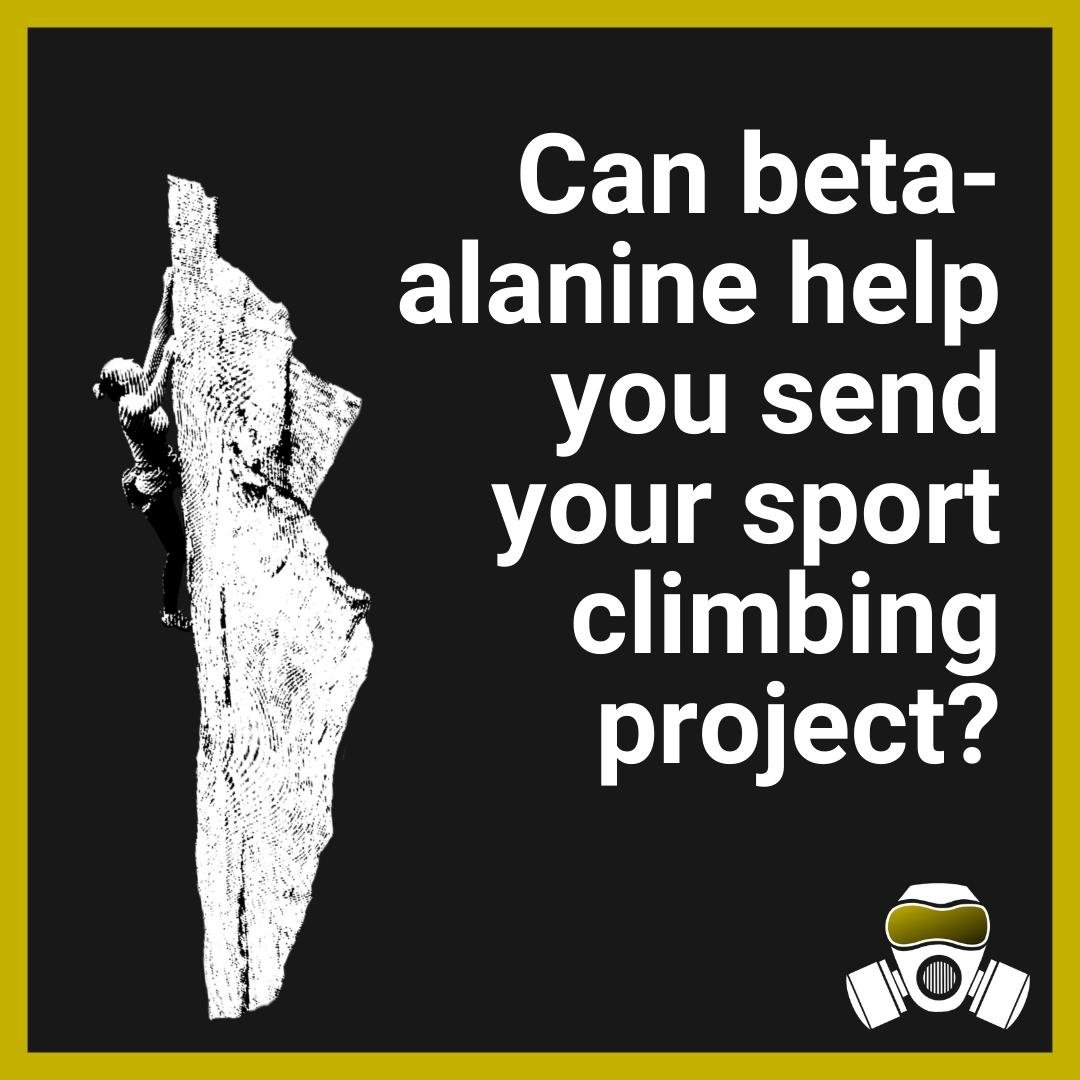

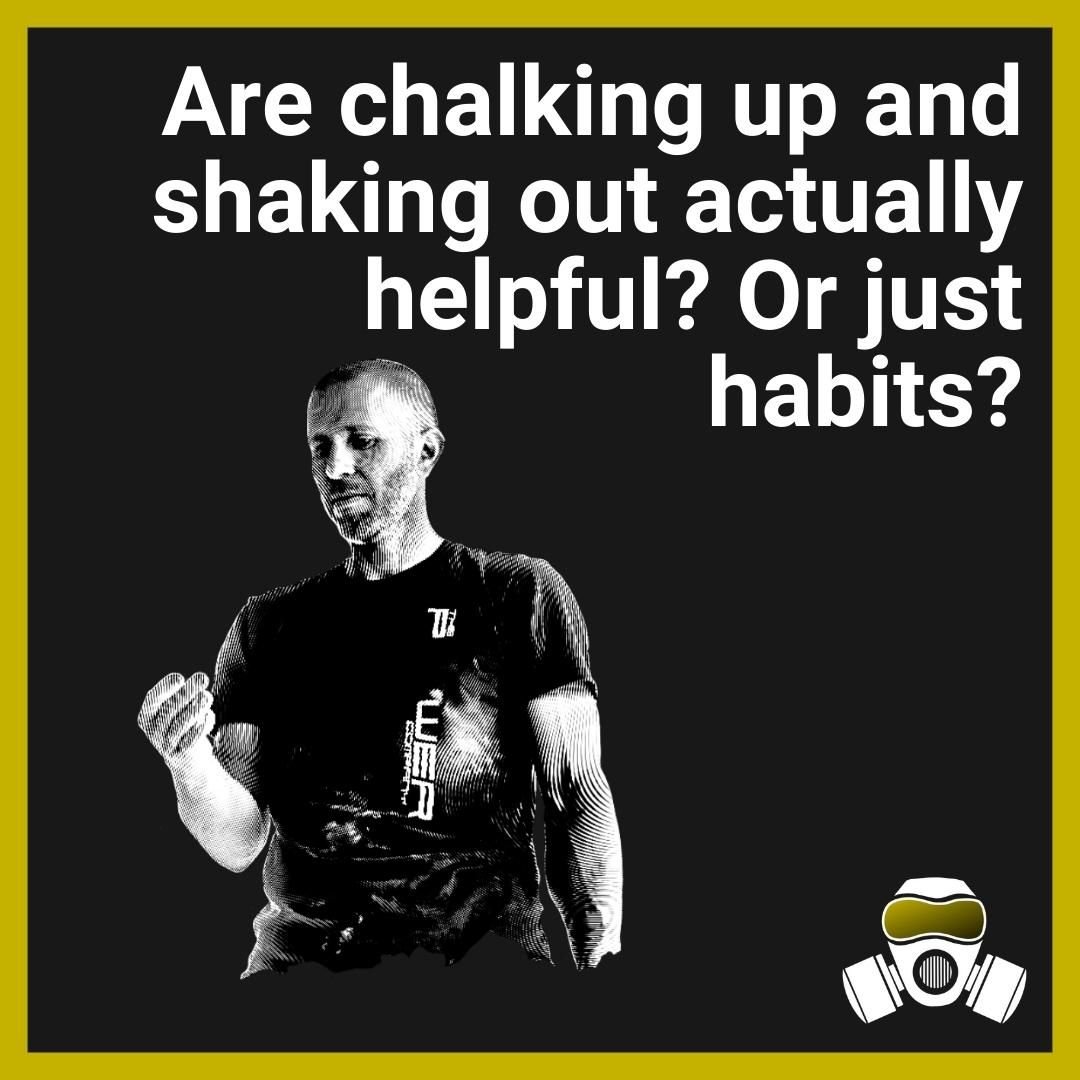



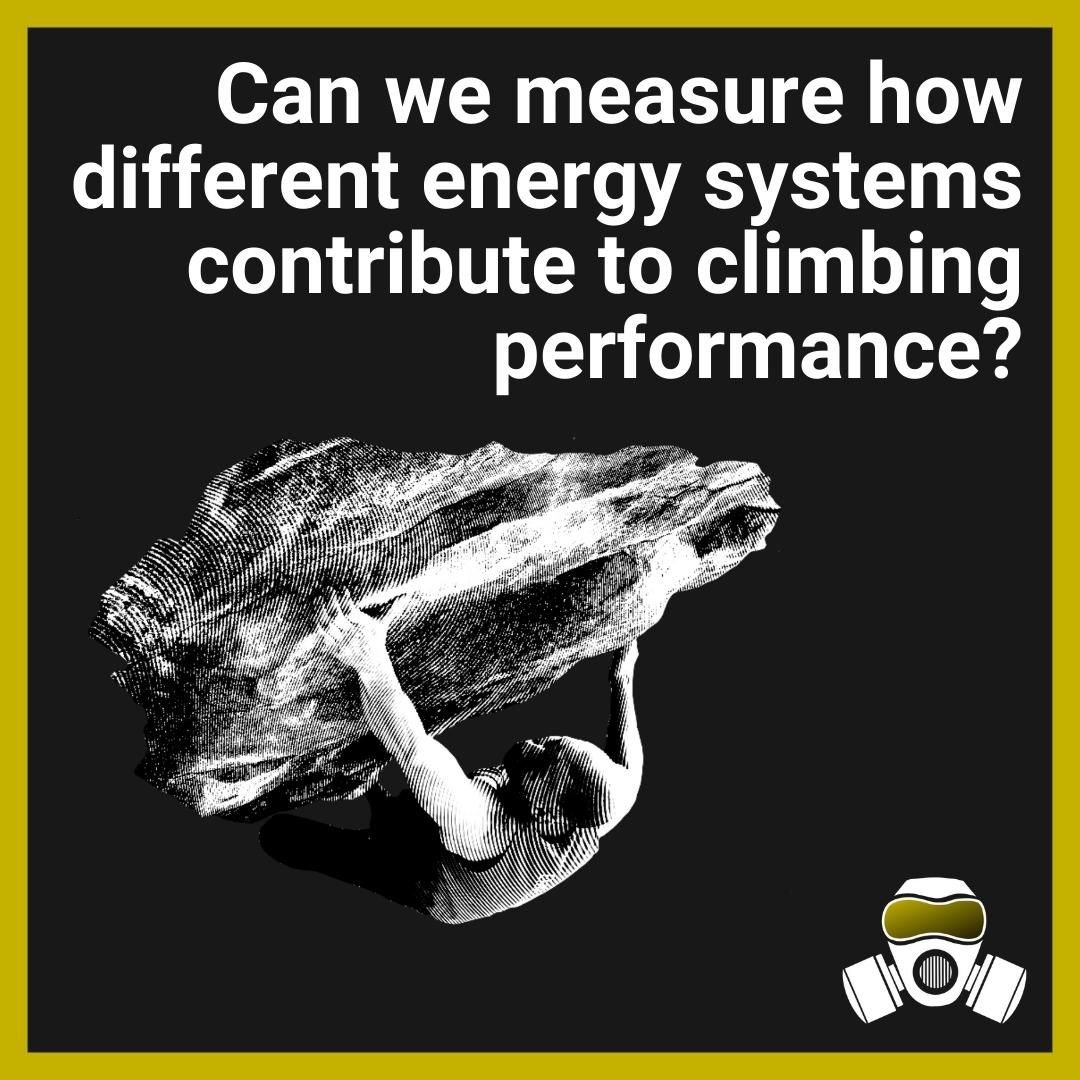
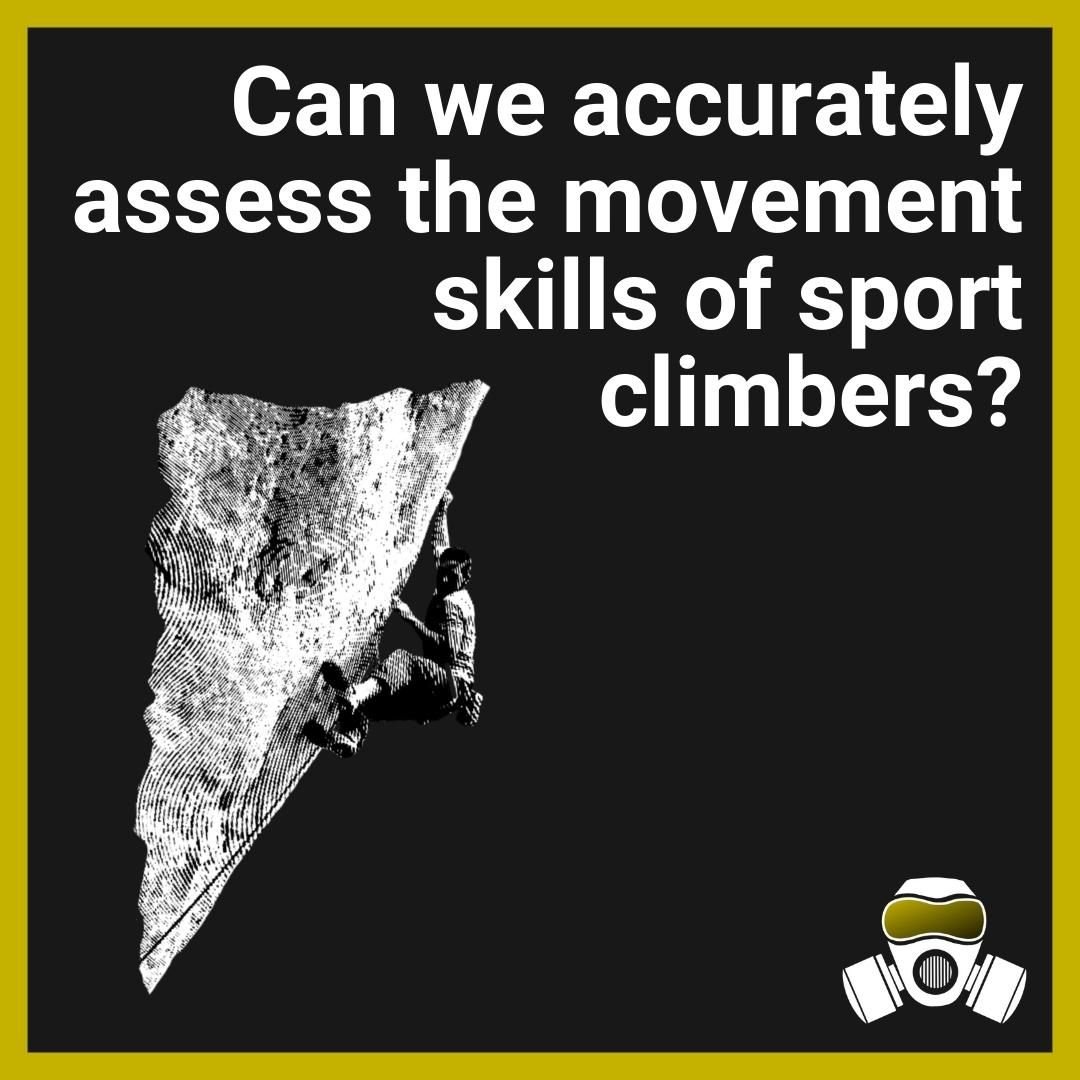
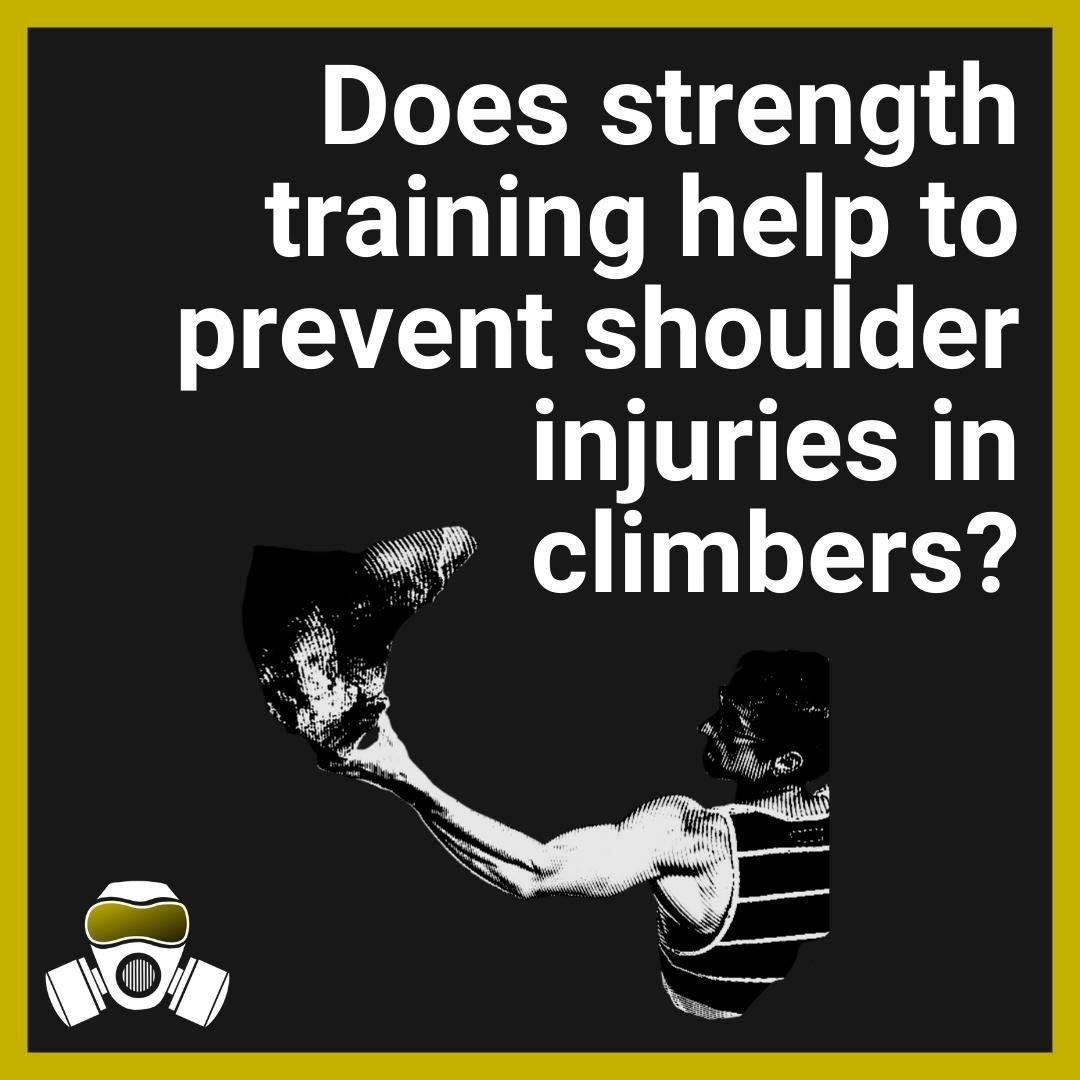









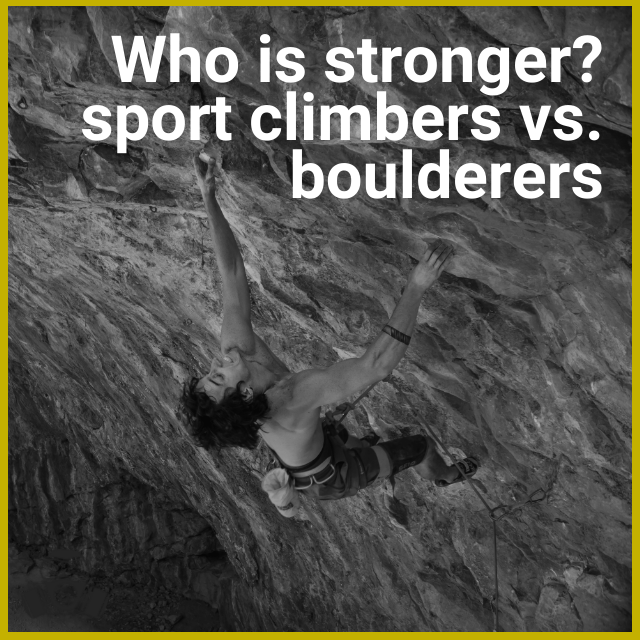

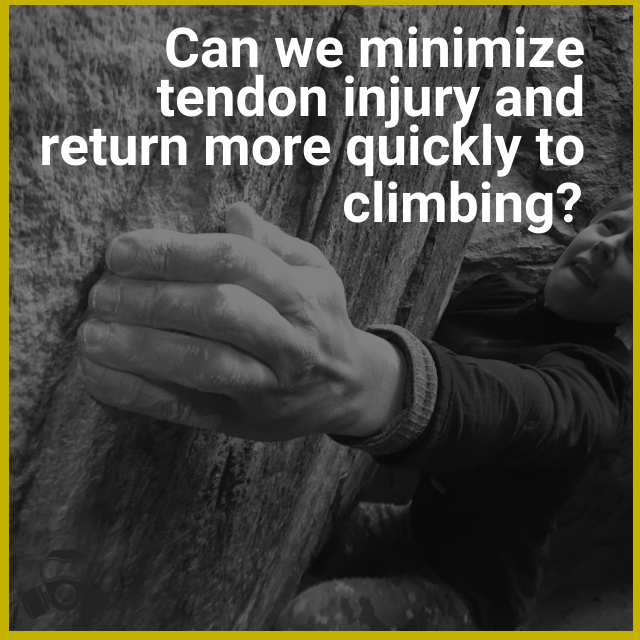
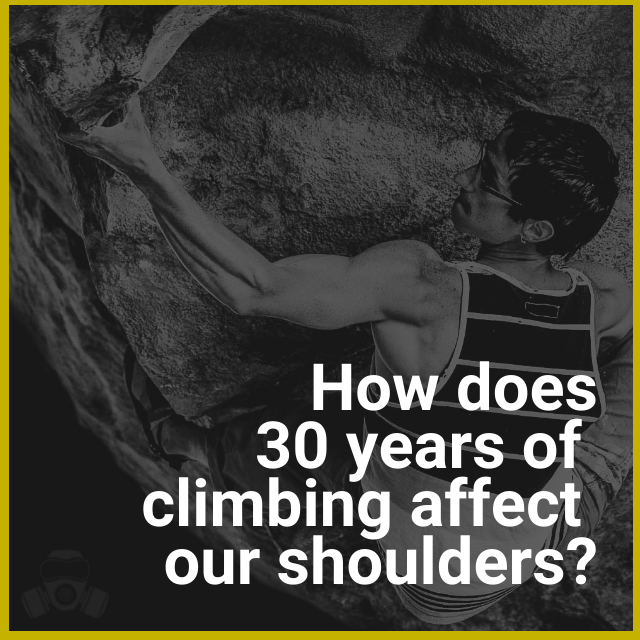

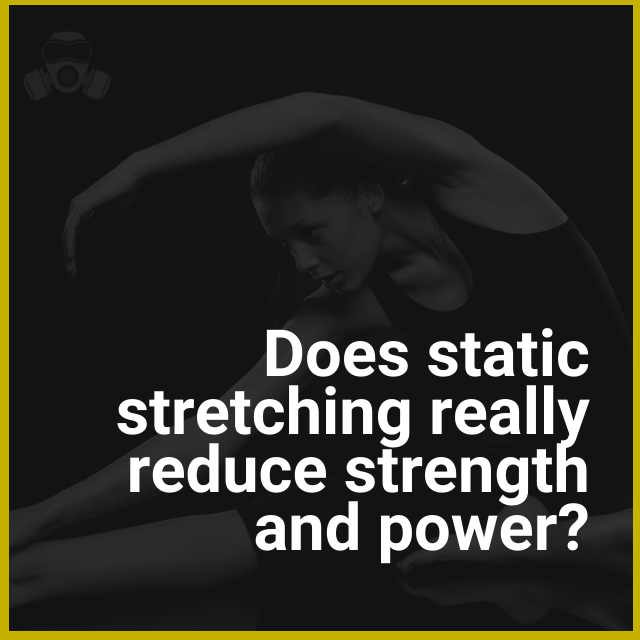







Explaining the science and calling out the misinterpretations.